How can you make a noisy, reverberant warehouse interior tolerable for workers?
Implementing targeted soundproofing techniques can transform even the loudest metal building into a peaceful sanctuary.
Let’s dive in to learn simple ways to block exterior clatter and contain interior dsoundproofing metal warehouse buildingsin through acoustic science.
Why Soundproof the Warehouse?
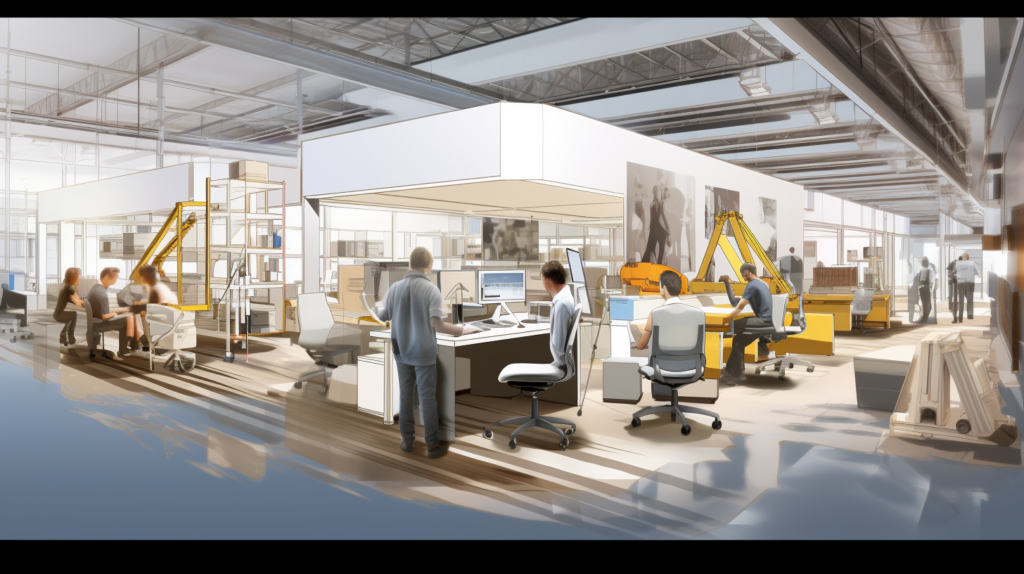
Working in noisy warehouse environments negatively impacts productivity, health, and safety of employees.
Prolonged exposure to excessive noise from equipment, vehicles, and workflow activities is a common issue in industrial settings that cannot be ignored.
Noise above safe decibel limits can cause hearing damage over time. Even at lower levels, noise hurts communication, increases errors, causes fatigue, and creates an unpleasant workspace.
Fortunately, there are several effective methods for soundproofing metal warehouse buildings to mitigate noise issues.
Properly designed acoustic modifications block exterior noise from entering and absorb echoes caused by reverberation within the space.
A soundproofed warehouse allows for better speech intelligibility, improved concentration, reduced mistakes, and a more comfortable environment.
This is especially important in large warehouses which typically have expansive, hard surfaces of concrete, sheet metal, and bare steel.
These materials exaggerately amplify noise since they lack absorption and facilitate reverberation.
Aisles between high racks also produce echo effects which increase volumes. Mitigating this challenging acoustics should be a priority.
In addition to boosting productivity and morale, proper warehouse soundproofing helps companies comply with occupational noise regulations.
Implementing acoustic treatment demonstrates a commitment to worker health and safety.
This guide covers techniques for soundproofing key components of typical metal warehouse buildings to achieve a quieter, OSHA compliant workspace.
Soundproof the Metal Walls
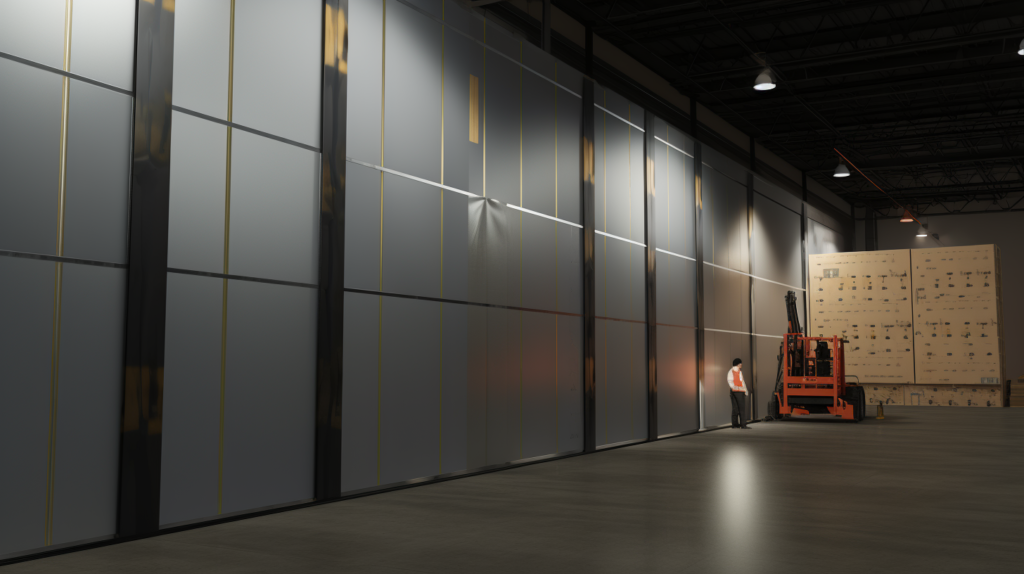
The metal exterior walls of most warehouse buildings provide minimal noise insulation. They act as pathways for external noise including traffic and industrial sounds to enter the interior space.
Sound waves vibrate the thin metal panels which radiates noise into the warehouse. Applying soundproofing materials and techniques to walls significantly blocks this noise transmission.
Installing sound isolation clips and furring channels is an important first step. The clips are attached to the interior wall surface and the channels screwed into the clips.
This creates a new inner wall layer that is decoupled from the exterior metal via an air gap.
The floating channel and clip system prevents noise from directly contacting and transferring through the metal skin. Any sound waves strike the new inner wall.
Next, pack sound absorbing insulation into the cavities between the metal wall and furring channel layer.
Use insulation materials especially designed for acoustics such as rigid fiberglass or rockwool batts.
The insulation absorbs noise frequencies trying to move through it while damping vibration in the metal behind it. This limits transmission into the warehouse.
Then, screw layers of drywall onto the furring channels using acoustical sealant between each sheet. Apply 2 to 3 layers of drywall for maximum noise blocking since mass is key.
The multiple dense drywall layers prevent noise that made it through the metal and insulation from continuing any further.
The acoustical sealant which contains damping compounds also isolates each layer which improves performance.
In addition, seal all perimeter edges and seams between drywall sheets with acoustic sealant as well.
Gaps and joints are weak points prone to noise leakage which compromise soundproofing efforts.
Filling them isolates any remaining flanking paths for noise to potentially transfer through. This maintains the acoustic integrity of the assembly.
Finally, install supplementary materials like mass loaded vinyl (MLV), acoustic panels, or noise damping composite to the walls.
MLV is a heavy, flexible vinyl sheet containing dense noise-blocking polymers. Panels are made of insulation or foam to absorb problematic frequencies.
Composite materials combine noise barriers and absorbers into one product. Adding these overlays further reduces any incidental sound passing through the walls.
Addressing the metal exterior walls is a key first component of a warehouse soundproofing strategy. Noise allowed through walls gets amplified within the large interior space.
Well treated walls block this primary transmission pathway. Next, apply similar isolation principles to the roof.
Soundproof the Metal Ceiling
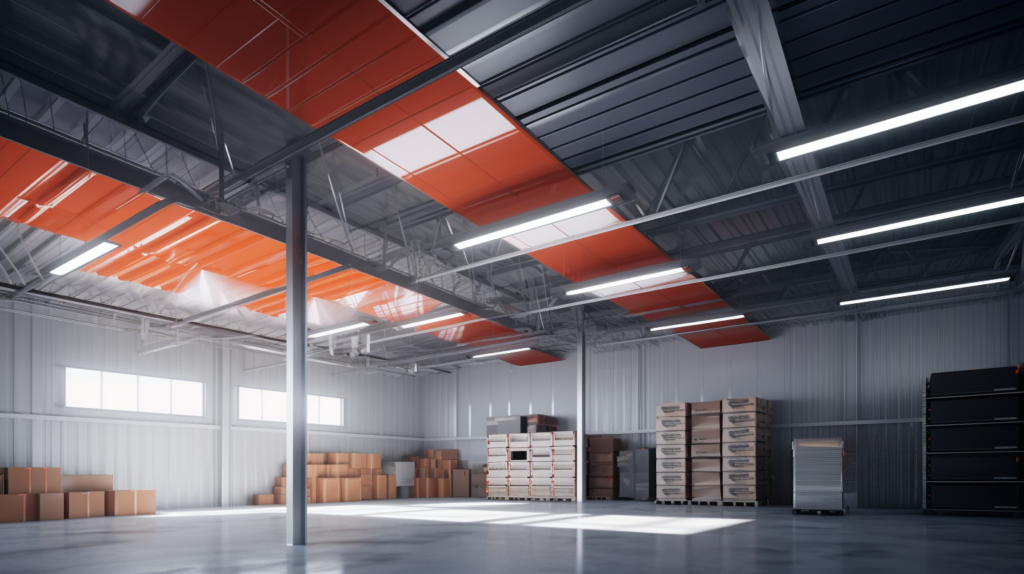
The metal exterior walls are not the only major conduit for noise to enter a warehouse. The metal roof panels also facilitate noise infiltration. Treat the metal ceiling assembly similar to the walls:
Attach resilient channels perpendicular to the roof rafters or trusses to decouple the drywall ceiling from the roof.
The channels create an isolation barrier between the metal roof and finished ceiling. This prevents transfer of noise and vibration from the exterior into the interior space.
Next, blow or pack soundproofing insulation like mineral wool into the spaces between metal rafters or trusses.
The insulation absorbs noise from the roof trying to make its way down into the warehouse. It also dampens vibration from the roof panels.
Leave enough space for the channel and drywall layers.
Then, screw sheets of drywall to the resilient channels using acoustical sealant between each layer. Apply at least two layers of drywall for optimal mass and isolation performance.
The channel and drywall assembly blocks noise transmission from the metal roofing above. Properly seal all perimeters with acoustic sealant as well.
In addition, consider adding a drop ceiling with acoustic ceiling tiles below the drywall for supplementary noise absorption within the space.
While the drywall addresses noise infiltration, tiles treat interior acoustics. The tiles absorb echo, reverberation and other noise generated inside the expansive warehouse.
This improves ambient sound quality.
Alternatively, install an acoustical plaster ceiling for a streamlined appearance if desired.
The textured, undulating surface of the specialized plaster absorbs high-frequency noise occurring within the space.
This achieves a smooth, unified look without the visible seams of ceiling tiles.
Carefully soundproofing the exterior building shell is vital. Next, address interior acoustics and containment.
Soundproof Metal Doors
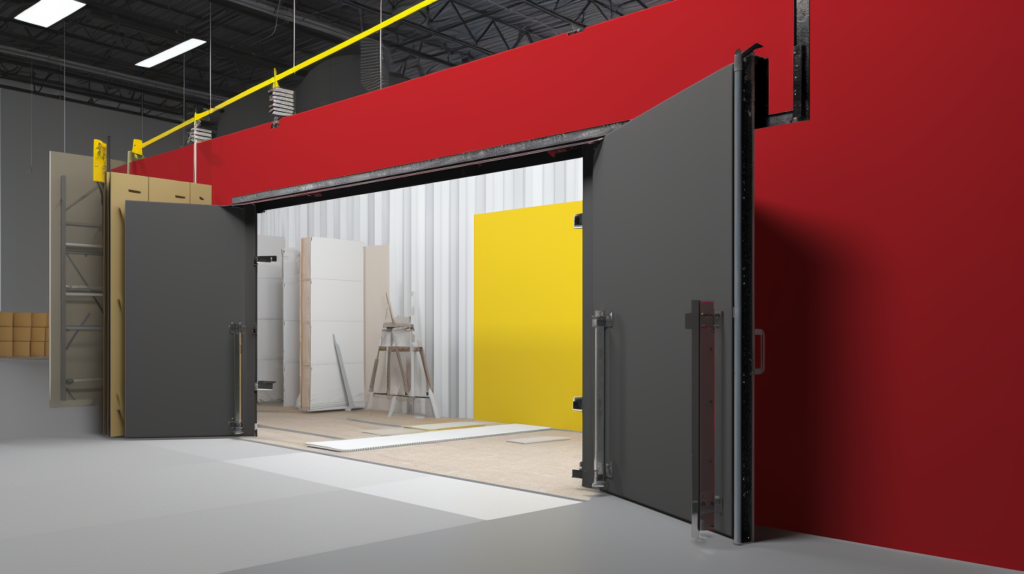
Another weak point often overlooked is interior metal doors. Thin hollow metal doors do little to block noise.
The bare metal reflects and amplifies sound, causing echo and reverberation issues within the warehouse. Replace hollow interior doors and apply treatments:
Swap standard hollow metal doors for solid core wooden or composite doors wherever possible.
Solid doors have much more mass and density to physically block noise compared to flimsy hollow metal ones.
Look for solid composite doors specifically engineered for soundproofing. These match the durability and fire ratings of metal.
Install high quality acoustic door seals on all interior and exterior doors.
Seals made of materials like silicone and EPDM compress when the door closes to completely fill the gaps around the door’s perimeter that would otherwise allow noise leakage.
Quality seals create an impermeable acoustic barrier.
Apply acoustic damping tiles or noise reducing panels directly to the door surfaces. The bare metal doors reflect noise.
Covering them with sound absorbing materials prevents this echo effect and reverberation. Materials like mass loaded vinyl, twisted fiber and foam absorb problematic frequencies.
Carefully sealing gaps and reducing reverberation caused by bare doors, walls and ceilings manages noise generation within the warehouse itself.
But the biggest offenders are often equipment and industrial activities. Isolating these noise sources is key.
Isolate Noisy Equipment
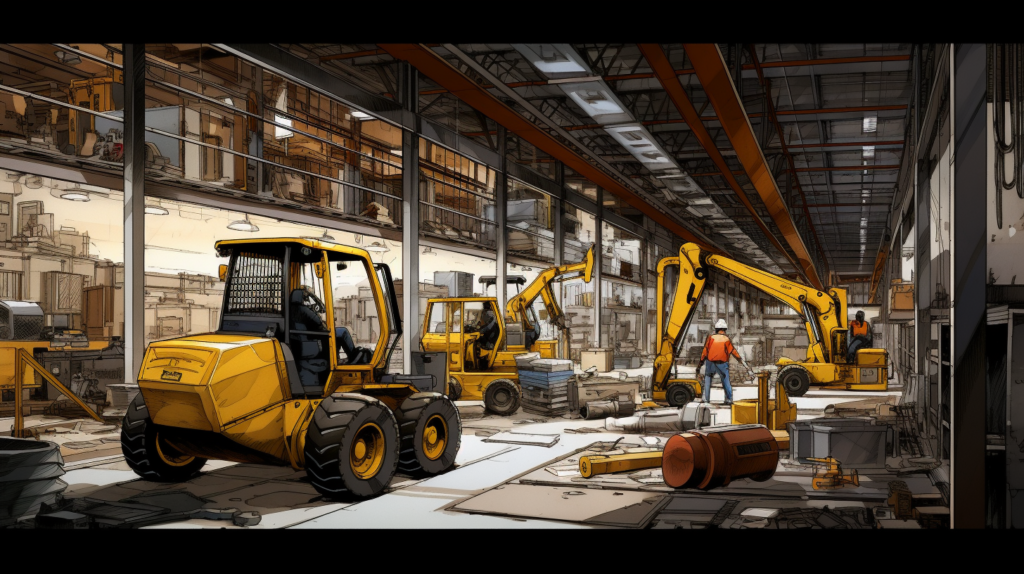
Equipment and processes inherently generate significant noise in warehouse and industrial settings.
Heavy machinery, motors, pneumatic tools, vehicle traffic, and material handling are unavoidable contributors.
While complete elimination may not be feasible, the impact can be reduced through isolation strategies:
Place noisy equipment like HVAC units on isolation pads made of dense rubber or neoprene.
These decouple the equipment from the building structure, preventing transfer of noise and mechanical vibration through the floor.
Use spring hangers to suspend noisy overhead equipment for the same isolating effect. Proper alignment and balance of equipment also reduces rattling noise.
Fix issues like worn bearings or gears.
Build enclosures around loud equipment and activities. Containing them within insulated walls prevents unchecked noise emission into the full warehouse space.
Acoustic doors, panels, and HVAC silencing further limit noise escape. Where total enclosure isn’t possible, erect partial barriers to block direct noise transmission pathways.
Relocate consistent noise sources away from employees to reduce exposure time.
Move noisy machinery like pneumatic saws or boxing apparatuses to the basement or a separate, enclosed room.
This also concentrates the noise for more effective mitigation measures. Limit foot traffic and material handling activities near these areas too.
Upgrade equipment over time to more efficient, low noise models when feasible. Newer motors, drives, vehicles, compressors, and fans generate less noise and vibration.
Maintain equipment according to manufacturer guidelines to further reduce noise. Lubricate moving parts, tighten components, and replace worn elements regularly.
Enclosures, distance, maintenance, and equipment selection are very impactful noise control techniques.
Also adjust operational schedules to separate noise activities from quiet tasks.
With a combination of proper building acoustics and operational noise discipline, an industrial setting can provide a safe, comfortable work environment.
Conclusion
Subjecting warehouse employees to excessive noise negatively impacts productivity, morale, safety, and health.
Prevent excessive noise exposure by soundproofing building components and isolating equipment sources.
Start by reducing external noise intrusion through walls, ceilings, and entrances. Manage interior acoustics by absorbing echo and reverberation.
Contain process and equipment noise with distance and barriers.
With growing awareness and regulation around hearing health and ergonomics, companies are investing more resources into effective warehouse soundproofing.
The techniques covered here demonstrate a commitment to compliance, safety, and workforce welfare.
Protect workers from noise related hazards while enabling them to operate at their full potential by soundproofing your metal warehouse facility.
A properly acoustically engineered space benefits all.
